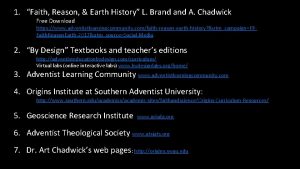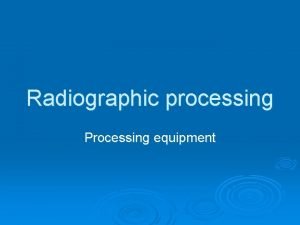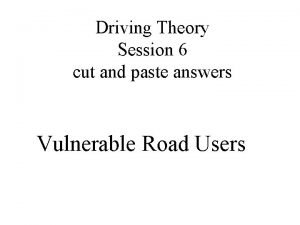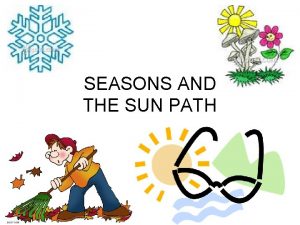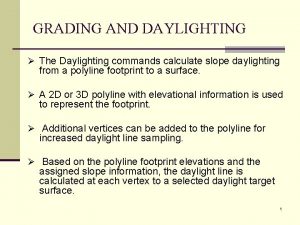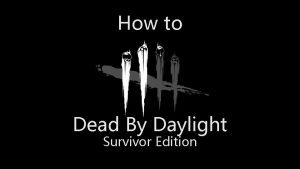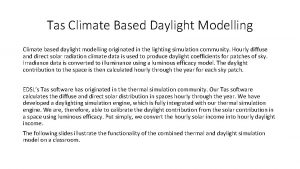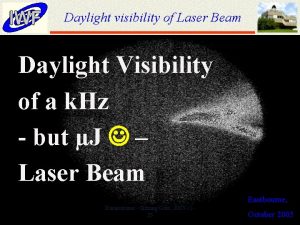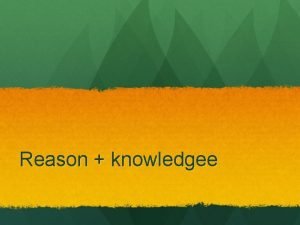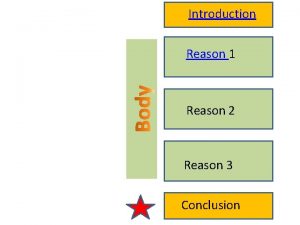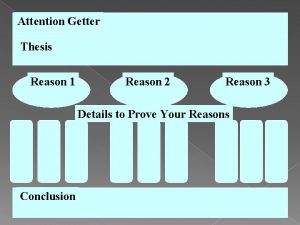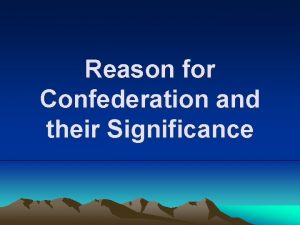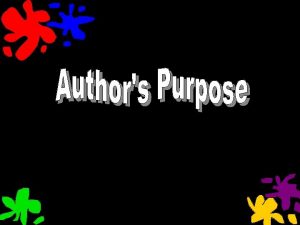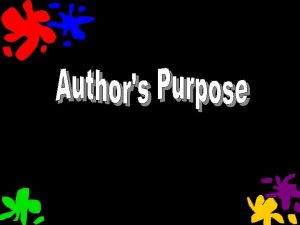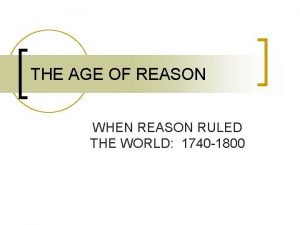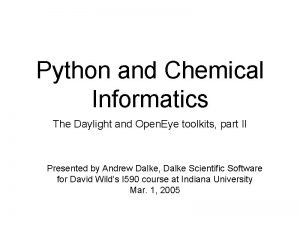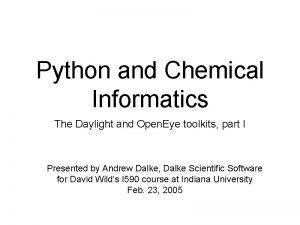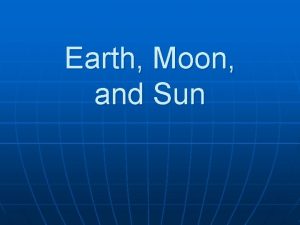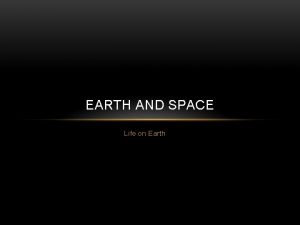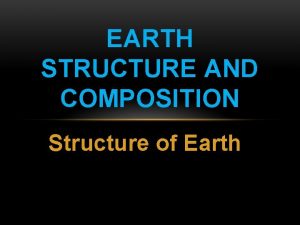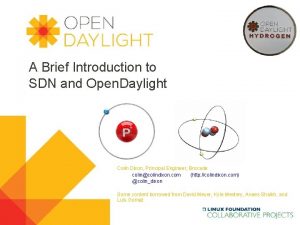Daylight on Earth and the Reason for the




























































- Slides: 60

Daylight on Earth and the Reason for the Seasons

Why do we experience day and night? The Earth is…

Day vs. Night When your location points toward the Sun, it is day. Then the Earth rotates you away from the Sun, and it is night. Sunlight Daytime Nighttime

Day and Night as the Earth is rotating on its AXIS

How long does one rotation take? 24 Hours! So remember, the earth is rotating much faster than it is revolving!

Here’s Mars… Where would you guess that it is COLDEST on Mars? If you guessed here… …and here… …you’re right. But why? And how did you know?

The key is that Planets are…

…and sunlight comes in from just one direction light ½ of Jupiter lit by the Sun

It’s all about CONCENTRATION! Look at a ray of sunlight hitting the middle of the planet. The ray hits this part of the planet directly, giving it a lot of energy (HEAT!), and focusing this energy over a small area. Venus, lit by the Sun

But at the north & south pole? Here comes a ray from the sun toward the south pole of Venus… the direct ray of light notice how much bigger an area the ray covers…this means it’s LESS concentrated! That same picture of Venus

So direct light heats planets up more than slanted light! Around the middle of the planet, the light is very focused and hits directly, heating that area up greatly. But at the top and bottom of the planet, the light comes in at a slant, meaning it warms those areas much less.

Illustrate how the sun hits the planet Here comes a ray from the sun toward the south pole of Venus… the direct ray of light notice how much bigger an area the ray covers…this means it’s LESS concentrated!

So that explains why… Up here we have… The best planet ever!

…and… Around here we have… The best planet ever!

…and… Down here we have… I’m cold The best planet ever!

This helps, but it doesn’t explain the seasons! So far we only know why the hottest part of each planet is around the middle…the sunlight hits that part most directly. If that was all that happened, though, we WOULDN’T have different seasons…just the same boring weather all year long. In Texas, it’d be about 90 degrees every day of the year with occasional rain. Not bad, but definitely BORING.

This is the key, so repeat after me… It’s… the…

The Earth doesn’t sit perfectly straight up and down A “false” view of Earth rotating on its axis. This just isn’t right!

Our Axis is TILTED! TILTED About 23. 5 degrees

A more accurate view… Notice the…

Remember from earlier… …That the middle of the planet gets the most direct sunlight (heat). COLD medium HOT medium COLD

So one half of the Earth “tilts” toward the sun! What does the tilt do? Direct light = Summer! Slanted down here = Winter! Which hemisphere of Earth (Northern or Southern) is having Summer & Winter in this diagram?

What does this mean for Texas? When our Northern Hemisphere tilts toward the Sun, we actually get nearly the most direct sunlight of anywhere on the planet! No wonder we get over 100 degrees so often in July & August!

And the final piece to the puzzle? So, the TILT is a big part of it, but something else must cause us to tilt either away or toward the Sun at different times during the year… …and that last bit is something you’ve known for years! The Earth revolves around the Sun! Watch the animation…pay attention to the direction Earth’s axis points as it orbits the Sun.

So…how do we get Winter in Texas? ? ? That happens when our (Northern) hemisphere tilts away from the sun 6 months after summer. Summer down here!

So it’s a combination of the TILTed axis and our revolving around the sun!

Complete the table 4 1 3 2 A hemisphere is experiencing summer if it is tilted directly toward the sun. A hemisphere is experiencing winter if it is tilted directly away from the sun.

Seasons Animation • http: //esminfo. prenhall. com/science/geo animations/01_Earth. Sun_E 2. html

Misconceptions about the Seasons 1. We experience seasons because Earth is closer to the sun in the summer and farther in the winter. Actually, the opposite is true. We are closer to the sun in the winter (91 million miles away) than we are in the summer (94 million miles away).

Notice the distance during the summer!

Which hemisphere in this picture would experience longer amounts of daylight? Why do you think so? Which part of the world would experience 24 hours of daylight each day? 24 hours of darkness each day?

Length of Day in Hemispheres 4 1 3 2 #1 June Day length England (Northern Hemisphere) – 15 hours and 38 minutes Australia (Southern Hemisphere) – 10 hours and 24 minutes

The Earth reaches 4 important points in its orbit 4 1 3 2 Position 1: June Solstice • About June 21 st • TX tilted toward Sun • We have our longest day, shortest night • Begins Summer

Three months later… 4 1 3 2 Position 2: September Equinox • About September 23 rd • TX tilt in between “toward” and “away” • 12 hrs day, 12 hrs night • Begins Fall

Three months later… 4 1 3 2 Position 3: December Solstice • About December 22 nd • TX tilted away from Sun • Shortest day, longest night • Begins Winter

Three months later… 4 1 3 2 Position 4: Vernal Equinox • About March 21 st • TX tilt half way between “toward” and “away” • 12 hrs day, 12 hrs night • Begins Spring

So, In Summary… If somebody asked you, “Why do we have seasons on Earth? ” you could now answer with great confidence… Fact 1: Round planets heat up wherever they get direct sunlight and are cooler at the tops and bottoms. Fact 2: The Earth’s axis is TILTED 23. 5 o. Fact 3: As Earth revolves around the Sun, the tilt causes differen parts of it to receive more or less sunlight for a few months, causing the weather and daylight to change.

Eclipses • The Sun, Earth and Moon occasionally line casting a shadow – Happen frequently – To see a solar eclipse, you need to be on a particular part of the Earth

Solar Eclipses • When the Moon comes between the Earth and the sun • Moon shadow covers part of the Earth • Only happens at New Moon

Why are solar eclipses only at New Moon? • During this phase the moon is not visible from Earth • The side of the moon that is facing us is not being lit by the sun.


Total Solar Eclipse • • Observers in the “umbra” shadow see a total eclipse (safe to view the Sun); can see the corona Those in “penumbra” see a partial eclipse—not safe to look directly at Sun Only lasts a few minutes Path of Totality about 10, 000 miles long, only 100 miles wide

Photo of a Total Eclipse http: //sunearthday. nasa. gov/2006/multimedia/gal_008. php

Photos of an Annular Eclipse http: //sunearthday. nasa. gov/2006/multimedia/gal_010. php; photos taken by Fred Espenak

Upcoming Solar Eclipses Insert upcoming Solar Eclipse dates • Next Total Solar Eclipse in USA— August 21, 2017

Lunar Eclipse • The Earth comes between the sun and moon • Shadow of Earth falls on moon • Only happen during a FULL MOON

When the Earth’s shadow covers the Moon, we have a lunar eclipse


Images from Fred Espenak http: //www. mreclipse. com/LEphoto/LEgallery 1. html

Why is the Moon red during an eclipse? • The Earth’s atmosphere filters some sunlight and allows it to reach the Moon’s surface • The blue light is removed—scattered down to make a blue sky over those in daytime • Remaining light is red or orange • Some of this remaining light is bent or refracted so that a small fraction of it reaches the Moon • Exact appearance depends on dust and clouds in the Earth’s atmosphere

Earth’s Habitable Zone • The distance from a star where a planet can keep water liquid and support carbon based life forms. • Important Things! 1. Atmosphere 2. Climate 3. Water 4. Light 5. Sun Click on photo for video!


Expert Notes: Page 19 • In your number groups, read over your passage. • Select three main ideas for your passage. • Write them down on page 19 with your group heading.

Group Notes • Go to your assigned area by the color of your number! • Share your expert notes with your group. • Each person should have the 5 reasons why with 3 main ideas written down on their paper by the end!

Atmosphere • Earth has oxygen and a breathe-able atmosphere • Doesn’t contain much carbon dioxide • Thick enough to block out bad rays from space (ozone layer)

Climate • Moderate amounts of Carbon Dioxide • Temperature stays about the same • Water is mostly liquid

Water • The most important chemical needed for life! • Drinkable, doesn’t burn • Found in 3 states on Earth: solid, liquid, gas

Light • Photosynthesis allows plants to turn light into food & oxygen • Even amounts of light and dark due to rotation • Enough to keep Earth warm

Sun • Without the sun there would be no life on Earth • Ideal distance from Sun • Perfect amount of heat & light • Keeps Earth warm

What would happen if Earth moved?
 Faith reason and earth history pdf
Faith reason and earth history pdf Cesario come for so you shall be
Cesario come for so you shall be Tosses his guts back into his body
Tosses his guts back into his body Simon armitage remains context
Simon armitage remains context Don't delay dawns disarming display. dusk demands daylight
Don't delay dawns disarming display. dusk demands daylight Baseball pick off plays
Baseball pick off plays Daylight processor
Daylight processor Motorcyclist dipped headlight
Motorcyclist dipped headlight Sun angles by season
Sun angles by season Daylight line grading
Daylight line grading Claudette morel bloodweb
Claudette morel bloodweb Climate based daylight modelling
Climate based daylight modelling Dead by daylight cex
Dead by daylight cex Iso 22301 utbildning
Iso 22301 utbildning Typiska drag för en novell
Typiska drag för en novell Tack för att ni lyssnade bild
Tack för att ni lyssnade bild Vad står k.r.å.k.a.n för
Vad står k.r.å.k.a.n för Shingelfrisyren
Shingelfrisyren En lathund för arbete med kontinuitetshantering
En lathund för arbete med kontinuitetshantering Personalliggare bygg undantag
Personalliggare bygg undantag Tidbok
Tidbok Sura för anatom
Sura för anatom Förklara densitet för barn
Förklara densitet för barn Datorkunskap för nybörjare
Datorkunskap för nybörjare Tack för att ni lyssnade bild
Tack för att ni lyssnade bild Hur skriver man en tes
Hur skriver man en tes Delegerande ledarskap
Delegerande ledarskap Nyckelkompetenser för livslångt lärande
Nyckelkompetenser för livslångt lärande Påbyggnader för flakfordon
Påbyggnader för flakfordon Tryck formel
Tryck formel Publik sektor
Publik sektor Jag har gått inunder stjärnor text
Jag har gått inunder stjärnor text Presentera för publik crossboss
Presentera för publik crossboss Vad är ett minoritetsspråk
Vad är ett minoritetsspråk Kanaans land
Kanaans land Klassificeringsstruktur för kommunala verksamheter
Klassificeringsstruktur för kommunala verksamheter Fimbrietratt
Fimbrietratt Bästa kameran för astrofoto
Bästa kameran för astrofoto Centrum för kunskap och säkerhet
Centrum för kunskap och säkerhet Byggprocessen steg för steg
Byggprocessen steg för steg Mat för idrottare
Mat för idrottare Verktyg för automatisering av utbetalningar
Verktyg för automatisering av utbetalningar Rutin för avvikelsehantering
Rutin för avvikelsehantering Smärtskolan kunskap för livet
Smärtskolan kunskap för livet Ministerstyre för och nackdelar
Ministerstyre för och nackdelar Tack för att ni har lyssnat
Tack för att ni har lyssnat Hur ser ett referat ut
Hur ser ett referat ut Redogör för vad psykologi är
Redogör för vad psykologi är Borstål, egenskaper
Borstål, egenskaper Tack för att ni har lyssnat
Tack för att ni har lyssnat Borra hål för knoppar
Borra hål för knoppar Vilken grundregel finns det för tronföljden i sverige?
Vilken grundregel finns det för tronföljden i sverige? Standardavvikelse formel
Standardavvikelse formel Tack för att ni har lyssnat
Tack för att ni har lyssnat Rita perspektiv
Rita perspektiv Verksamhetsanalys exempel
Verksamhetsanalys exempel Tobinskatten för och nackdelar
Tobinskatten för och nackdelar Toppslätskivling dos
Toppslätskivling dos Gibbs reflekterande cykel
Gibbs reflekterande cykel Egg för emanuel
Egg för emanuel Elektronik för barn
Elektronik för barn
